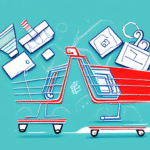Ecommerce Enablement: Preparing Your Business for Digital Transformation
In today's digital age, ensuring your business is accessible online is more crucial than ever. Ecommerce enablement allows businesses to transform their operations, reach a broader audience, and increase sales opportunities. But what exactly is ecommerce enablement, and why is it vital for your business? Let's explore in detail.
The Importance and Benefits of Ecommerce Enablement
Ecommerce enablement refers to the process of digitizing your business to enhance its online presence and functionality. This includes creating an ecommerce website or application, integrating secure payment gateways, and establishing efficient online shopping carts. According to a recent Statista Forecast, global ecommerce sales are projected to reach $6.54 trillion by 2023, underscoring the immense potential for businesses to expand their market reach.
Expanding Market Reach
By enabling ecommerce, businesses can transcend geographical limitations, tapping into global markets and accessing a diverse customer base.
Enhanced Data Collection and Analysis
Ecommerce platforms facilitate the collection of valuable customer data, providing insights into purchasing behaviors and preferences. This data can inform targeted marketing strategies and personalized customer experiences.
Cost Reduction and Operational Efficiency
Automation of processes such as order fulfillment and inventory management reduces operational costs and minimizes human error, allowing businesses to allocate resources more effectively.
Implementing Ecommerce Enablement: Steps and Best Practices
Successful ecommerce enablement requires strategic planning and execution. Here are the key steps to guide your implementation:
Assessing Your Current Business State
Begin by evaluating your existing operations, identifying strengths and areas for improvement, and setting clear ecommerce objectives aligned with your business goals.
Selecting the Right Tools and Resources
Choose an appropriate ecommerce platform, reliable payment gateways, and other essential tools that support your business needs. Platforms like Shopify and WooCommerce are popular choices.
Developing a Detailed Plan and Timeline
Create a comprehensive plan outlining each step of the implementation process, assign responsibilities, and set achievable timelines to ensure smooth execution.
Collaborating with Experts
Engage with experienced ecommerce professionals or agencies who can provide valuable insights and assist in navigating the complexities of digital transformation.
Choosing and Optimizing Your Ecommerce Platform
Selecting the right ecommerce platform is critical to your business's success. Consider the following factors when making your choice:
Ease of Use and User Interface
The platform should offer an intuitive interface that facilitates easy management of products, orders, and customer interactions.
Scalability and Flexibility
Ensure the platform can scale with your business growth and adapt to changing market demands without requiring significant overhauls.
Security Features
Robust security measures, including SSL certificates and secure payment processing, are essential to protect customer data and build trust.
Customization and Integration
Look for platforms that allow extensive customization and integration with other tools and services, such as CRM systems and marketing applications.
Cost Considerations
Evaluate the total cost of ownership, including setup fees, transaction fees, and ongoing maintenance costs, to ensure they fit within your budget.
Top Features to Look for in an Ecommerce Platform
- User-Friendly Interface: Simplifies navigation and management for both customers and administrators.
- Responsive Design: Ensures optimal viewing and interaction across all devices, including smartphones and tablets.
- Secure Payment Processing: Supports multiple payment options while ensuring transaction security.
- Social Media Integration: Facilitates seamless connection with social media platforms for marketing and sales purposes.
- Robust Analytics and Reporting: Provides insights into sales performance, customer behavior, and website traffic.
- SEO-Friendly Architecture: Enhances search engine visibility through optimized URLs, meta tags, and site structure.
- Customization Options: Allows for personalized branding, layout adjustments, and the addition of custom functionalities via plugins or extensions.
Enhancing Customer Experience and Security
A seamless customer experience coupled with robust security measures is crucial for building trust and driving sales. Here’s how to achieve it:
Intuitive Navigation and User Interface
Design your website with easy-to-navigate menus, clear calls-to-action, and a streamlined layout that facilitates effortless browsing and purchasing.
Multiple Payment Options
Offer a variety of payment methods, including credit cards, digital wallets, and other popular solutions to accommodate diverse customer preferences.
Secure Payment Processing
Integrate reliable payment gateways such as PayPal and Stripe, ensuring transactions are secure and customer data is protected.
Efficient Customer Support
Provide prompt and helpful customer service through multiple channels, such as live chat, email, and phone support, to address customer inquiries and issues effectively.
Managing Operations and Analyzing Performance
Effective management of operations and constant performance analysis are essential for sustaining ecommerce success.
Inventory Management Tools
Utilize inventory management systems that track stock levels, manage product listings, and automate reordering processes to prevent stockouts and overstock situations.
Efficient Order Fulfillment
Streamline your order fulfillment process by integrating with reliable logistics partners, implementing automated packing and shipping systems, and ensuring timely delivery to customers.
Tracking Key Performance Metrics
Monitor metrics such as website traffic, conversion rates, and average order value using tools like Google Analytics to assess and enhance your ecommerce strategies.
Using Analytics Tools
Leverage tools like Google Analytics, Hootsuite Analytics, and platform-specific dashboards to gather and analyze data, enabling you to make data-driven decisions.
Overcoming Challenges and Embracing Future Trends
Implementing ecommerce enablement strategies can present several challenges, but with the right approach, they can be effectively addressed. Additionally, staying informed about future trends ensures your business remains competitive and innovative.
Common Challenges and Solutions
- Choosing the Right Platform or Provider: Conduct thorough research and consult with ecommerce experts to select a platform that aligns with your business goals.
- Managing Inventory and Fulfillment: Invest in robust inventory management systems and partner with reliable logistics providers to ensure efficient operations.
- Optimizing for Search Engines: Implement comprehensive SEO strategies, including keyword optimization and content creation, to enhance your site's visibility.
- Providing a Seamless Customer Experience: Focus on website usability, offer multiple payment options, and personalize the shopping experience to meet customer expectations.
Future Trends in Ecommerce Enablement
- Artificial Intelligence and Chatbots: AI-powered tools enhance customer service by providing instant support and personalized recommendations.
- Personalized Shopping Experiences: Advanced data analytics enable highly personalized interactions, increasing customer engagement and loyalty.
- Voice Commerce Integration: Voice assistants like Amazon Alexa and Google Assistant facilitate voice-activated shopping, offering a hands-free purchasing experience.
- Augmented Reality (AR) and Virtual Reality (VR): AR and VR technologies allow customers to visualize products in real-world or virtual settings, enhancing the decision-making process.
- Sustainable and Ethical Ecommerce Practices: Consumers increasingly prioritize sustainability, prompting businesses to adopt eco-friendly operations and transparent supply chains.
Overall, ecommerce enablement is essential for businesses aiming to thrive in today's digital economy. By embracing digital transformation, implementing effective strategies, and staying informed about emerging trends, businesses can expand their reach, enhance customer experiences, and achieve sustained growth.






















